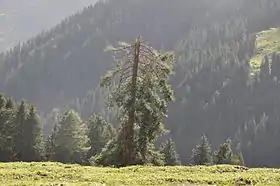Elum Ghar
Elum Ghar (also known as Mount Ilam) is a 2,800 metres (9,200 ft) mountain located on the border of the Swat and Buner districts of Pakistan. Elum Ghar is the highest peak in the region and is snow-covered most of the year. It is located west of Pir Baba's shrine in the Buner District of the Khyber Pakhtunkhwa province of Pakistan.[1] The mountain was a significant pilgrimage site for Hindus until 1947, and is believed to be the site where a previous incarnation of the Buddha gave up his life.[2]

History

Archaeologists have found ruins of the Indus Valley civilization around the mountain, and believe that there may still be more buried ancient ruins. This site is significant in Hinduism.
Ilam Ġhar's peak is called Jūgyānū Sar in local language, which is linked to the belief that Rām Taḫt, a place of spiritual importance, was situated here. In the Hindu tradition, devotees held Rām Taḫt in high reverence, considering it to be the spot where Rām Čandar, an incarnation of Lord Rama, spent a portion of his banbās, or "forest-dwelling" period here.[3] This tradition is not mentioned in the Rāmāyaṇa of Vālmīki. Hindus used to celebrate Sawan Sangran every year at Rām taḫt. On the first night of Sawan, they would hold vigil, worship, and recite their holy book. At dawn, the paṇḍit would lead them up the mountain to Rām taḫt, where praśād(holy offering) would be distributed and circumambulation would be performed around the site. The site had shades for the Hindu pilgrims until they were removed by the Wāli of Swat, Miangul Abdul Wadud. The festival is no longer celebrated.[4]
The mountain has snakes and cobras near the top. There is a local proverb that says, Maar chey zwaan shi nu da elum ghar ta laar shi, which means, When a snake reaches its youth, it goes to Mount Elum.
According to the Indologist Giuseppe Tucci's proposal, the rock of Aornos is at the summit of Elum Ghar (Mount Ilam). Alexander the Great's forces faced a tough battle on this site. However, there are other possible sites for the rock of Aornos identified such as Pir Sar in Shangla.
Geography
From the summit of the mountain, the city of Mingora can be seen. The mountain is popular among hikers due to various streams and lakes that can be seen while going up the mountain. However, The ascent can be quite challenging due to the absence of local transportation options.
Festivals
Every year, at the end of July or at the beginning of August, the festival of Jushn-e-Elum is held. It is celebrated by the youth from nearby villages, The celebration is an opportunity to get out of the heat of the valley and stay for a couple of days on the cooler mountain.
References
- "Elum Mountain". paktourismportal.com.
- "Elum Mountain: Highest Peak in Buner". tripako.com. Retrieved 23 August 2021.
- Sultan-i-Rome (2021). "Indigenous People of the Swat Valley". In Marine, Carrin; Michel, Boivin (eds.). Brill's Encyclopedia of the Religions of the Indigenous Peoples of South Asia. Handbuch der Orientalistik. Vol. 36. Brill.
- Sultan-i-Rome (2012). "Religious Perspective of Pre-Muslim Swat". Journal of Asian Civilizations. 35 (2): 118–119.